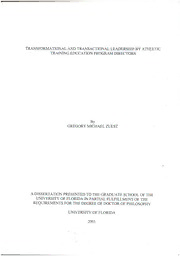
Transformational and transactional leadership by athletic training education program directors PDF
Preview Transformational and transactional leadership by athletic training education program directors
TRANSFORMATIONALANDTRANSACTIONALLEADERSHIPBYATHLETIC TRAININGEDUCATIONPROGRAMDIRECTORS By GREGORYMICHAELZUEST ADISSERTATIONPRESENTEDTOTHEGRADUATESCHOOLOFTHE UNIVERSITYOFFLORIDAINPARTIALFULFILLMENTOFTHE REQUIREMENTSFORTHEDEGREEOFDOCTOROFPHILOSOPHY UNIVERSITYOFFLORIDA 2003 ACKNOWLEDGEMENTS IwouldliketobeginbythankingmycommitteemembersfromtheDepartmentof EducationalLeadership,PolicyandFoundations,Drs.DavidHoneyman,JamesDoud, andDaleCampbell,fortheirguidanceandpatiencethroughouttheyearsofmydoctoral studyattheUniversityofFlorida.IwouldalsoliketothankDr.MaryBethHorodyski, whosetirelessdedicationtoherfamily,students,andprofessioncontinuetoamazeme evenafter11years! NeitherthisnoranyothersuccessIhavehadinmylifewouldhavebeenpossible withouttheloveandsupportofmyfamilyandfriends.Ithankthemverymuchfor everything.Finally,Iwouldliketothankmyboss,Dr.SvenNormann,forbeingatruly transformingleader. n 1 TABLEOFCONTENTS page ACKNOWLEDGMENTS ii ABSTRACT CHAPTER 1INTRODUCTION \ StatementoftheProblem 6 PurposeoftheStudy 7 DefinitionofTerms 8 Limitations 10 SignificanceoftheStudy 10 Summary 1 2.REVIEWOFTHELITERATURE 13 TransformationalLeadershipTheories 13 RelatedResearchonBass’Model 22 RelatedTheories 24 ChangeandTransformationalLeadershipinHigherEducation 28 AthleticTrainingEducationProgramsandFacultyResponsibilities....33 ChangeinAthleticTrainingEducationPrograms 36 Summary 3g 3.DESIGNOFTHESTUDY ResearchPopulation 41 ProcedureforDataCollection 41 Instrumentation 42 StatisticalAnalysis 40 Summary 4^ iii 4.PRESENTATIONANDANALYSISOFTHEDATA 48 SurveyResponses 49 PopulationProfile 49 ResearchQuestion1 50 ResearchQuestion2 52 Summary 56 5. FINDINGS,CONCLUSIONS,ANDIMPLICATIONS FORFUTURERESEARCH 58 FindingsandConclusions 59 ImplicationsandSuggestionsforFutureStudy 68 APPENDIX COVERLETTERANDSURVEYINSTRUMENTS 74 REFERENCELIST 78 BIOGRAPHICALSKETCH 85 IV AbstractofDissertationPresentedtotheGraduateSchooloftheUniversityofFloridain PartialFulfillmentoftheRequirementsfortheDegreeofDoctorofPhilosophy TRANSFORMATIONALANDTRANSACTIONALLEADERSHIPBYATHLETIC TRAININGEDUCATIONPROGRAMDIRECTORS By GregoryMichaelZuest December2003 Chair:DavidS.Honeyman MajorDepartment: EducationalLeadership,PolicyandFoundations Thebeginningofthe21stcenturybroughtaboutarapidlychangingeducationaland economicenvironment,makingtheneedforleadershipinathletictrainingeducation programsofparamountimportance.Tosuccessfullyovercomeeducationalreformsand increasingdemandsplacedonfaculty,programdirectorsmustprovideleadershipthat inspiresandallowsfacultymemberstoperformatoptimallevels. ThepurposeofthisstudywastoinvestigatetheapplicabilityofBernardBass’Full- RangeofLeadershipModeltoathletictrainingeducationprogramdirectors.Bass’model includesninedistinctleadershipfactorsincludingfivetransformational,three transactional,andthenon-transactionalfactorlaissez-faireleadership.Asecondary purposewastoinvestigatetherelationshipbetweenninemeasuresofleadershipbehavior includedinBass’model,fourmeasurementsofleadershipexperience,andthethree measuresofleadershipoutcomeincludedinBass’model. v TheMLQ-5Xwasutilizedtoascertaintheprogramdirectors’perceptionsoftheir leadershipbehaviorsaswellastheleadershipoutcomemeasurementsofleader effectiveness,followersatisfactionwiththeleader’smethods,andextraeffortin followers.Programdirectorswerealsoaskedtocompletealeadershipexperience questionnairethatassessedfourleadershipexperiencemeasures. Analysisofthesurveyresultssuggestedthatprogramdirectorsperceivedthemselves asutilizingthefivetransformationalleadershipbehaviorsandthetransactionalleadership behaviorcontingentrewardtoagreaterdegreethanthetransactionalleadershipbehaviors ofmanagement-by-exceptionactiveandpassiveandthenon-leadershipbehaviorlaissez- faire.Comparingacompositeprofileofprogramdirectors’leadershipbehaviorstoBass’ “optimal”leadershipprofilerevealsthatprogramdirectors’leadershipwasnotlikelyto matchthe“optimal’profileduetothefrequentuseofthetransactionalleadership behaviorcontingentreward. Regressionanalysesrevealedfivesignificantrelationshipsbetweenthethree leadershipoutcomesmeasuredontheMLQ-5X,nineleadershipbehaviorsmeasuredon theMLQ-5Xandfourmeasurementsofleadershipexperience.Inspirationalmotivation wassignificantlyrelatedtoallthreeleadershipoutcomes,whileidealizedinfluencewas significantlyrelatedtofollower’ssatisfaction,andcontingentrewardwassignificantly relatedtoleader’seffectiveness.Theserelationshipssuggestthatastheuseofthese leadershipbehaviorsincreasessodoestheoutcomemeasure. Norelationshipswere foundbetweenleadershipoutcomesandleadershipexperiencemeasures. vi CHAPTER 1 INTRODUCTION Thebeginningofthe21stcenturybroughtaboutarapidlychangingeducationaland economicenvironment,makingtheneedforleadershipinathletictrainingeducation programs(ATEP)ofparamountimportance(Peer&Rakich,2000).Educationalreform inthefieldofathletictrainingplacedgreatdemandsuponprogramdirectorsandtheir facultymemberstoadapttonewdidacticandclinicalaccreditationstandards(Mangus, 1998).PeerandRakich(2000)statedthateducationalleadersmustprovideboth transactionalandtransformationalleadershipifathletictrainersaretosecurealegitimate placeashealthcareprovidersinthehighlycompetitivemanagedcareenvironment.A deepunderstandingofmanagementandleadershiptheorywillhelpguideprogram directors’behaviorstowardstheseends.However,accordingtoRankinandIngersoll (1995),managementtheoryisanareaofdevelopmentthathasbeenvirtuallyignoredin athletictraining. Leadershiphasbeenstudiedforatleasttwomillennia(Bums,1978);however,no singledefinitionofleadershiphasbeenusedconsistentlyintheresearch(Komives,Lucas &McMahon,1998).DefinitionshaverangedfromHerseyandBlanchard’s(1993)belief thatleadershipis“theprocessofinfluencingtheactivitiesofanindividualoragroupin effortstowardgoalachievementinagivensituation”(p.94)toBums’(1978)viewof leadershipas“thereciprocalprocessofmobilizing,bypersonswithcertainmotivesand values,variouseconomic,political,andotherresources,inacontextofcompetitionand 1 2 conflict,inordertorealizegoalsindependentlyormutuallyheldbybothleadersand followers”(p.425).Thoughnumerousdefinitionshavebeenusedintheliterature,nearly allthedefinitionshavetreatedleadershipas“agroupphenomenoninvolvingthe interactionbetweentwoormorepersons”inwhich“intentionalinfluenceisexertedby theleaderoverfollower”(Yukl,1989,p.3). Earlyleadershipliteraturehadaone-dimensionalfocus.Forexample,thegreatman theoriesandtraittheoriesfocusedontheleader’shereditaryendowmentsandnatural abilitiesrespectively.Inthe1950s,researchersbegantostudytheobservablebehaviorof leaders.Thisresearchincludedtheanalysisof“whatmanagersactuallydoonthejob” (Yukl,1994,p.12),andcomparisonsofthebehaviorsofeffectiveandineffectiveleaders. However,thebehavioristapproachtoleadershipignoredsituationalvariablesandgroup processesresultingininconclusiveandinconsistentfindings(Komivesetal.,1998). “Whereweoncethoughtofleadershipasarelativelysimpleconstruct,wenowrecognize thatitisamongthemorecomplexsocialphenomena”(Heilbrunn,1994,p.66). Leadershipresearchinthelate20thcenturyfocusedonleadershipasamulti- dimensionalconstructincludingtheleader,therelationshipbetweentheleaderandhis followers,andthesituationalvariablessurroundingtheleader/followerdyad.These theoriesincludedFiedler’s(1967)ContingencyModel,HouseandMitchell’s(1974) Path-GoalModel,andHerseyandBlanchard’s(1988)SituationalLeadershipModel. Severaltheoristshaveinvestigatedthegrowth-orientedleadershipstylesof “visionary”or“exceptional”leaders(Bennis&Nanus,1985;Sashkin&Fulmer,1985). Thesetheoristspostulatedthattheseleadershavetheabilitytoarticulateavisionand bringaboutnoticeablegrowthintheirfollowers,aswellastheirorganizations.Theyalso 3 statedthatvisionattractscommitmentandenergizespeople,createsmeaning,establishes astandardofexcellence,bridgesthepresentandthefuture,andempowersfollowers (Nanus,1992). Finally,twotheories,Bums’(1978)TransformationalLeadershipModeland Greenleafs(1977)ServantLeadershipTheory,werebasedonthereciprocalnatureofthe leader-followerinteraction.Thesetheoriesemphasizedmutualgoalsandmotivationsof theleadersandfollowers,aswellasempowermentandelevationofthefollower. BuildinguponBums’(1978)TransformationalLeadershipModelandincorporating aspectsofvisionarytheories,Bass(1985)proposedachange-basedmodelofleadership. BothBums’(1978)andBass’(1985)modelswerebasedonthebehaviorally dichotomousstylesofleadership,transactionalleadershipandtransformational leadership,anddistinguishedbetweenhigherandlowerorderchangeinfollowers.Bass statedthattransactionalleadershipisbasedoncost-benefitsandeconomicexchangesto meetfollowers lowerordermaterialandpsychicneedsinreturnforservicesrenderedby thesubordinate.Bums(1978)statedthattransformationalleadersrecognizetheselower orderneedsinsubordinatesbutgofurthertosatisfyfollowers’higherorderneedsand morefullyengagethefollower.Bass(1985)explainedthattransformationalleaderscan succeedinmovingfollowersfromalowerlevel(order)toahigherlevel(order)ofneed, accordingtoMaslow’s(1954)HierarchyofNeeds,byincreasingthefollowers’maturity levelofneedsfromsecurityandaffiliationtoconcernsforrecognition,achievement,and self-actualizing. Bums(1978)consideredleadershiptobetransactionalwhenfollowersaremotivated byexchangingrewardsforservicesperformed.Forexample,hestatedthatpolitical 4 transactionalleaders“approachfollowerswithaneyetoexchangingonethingfor another:jobsforvotesorsubsidiesforcampaigncontributions.Suchtransactions comprisethebulkoftherelationshipsamongleadersandfollowers,especiallyingroups, legislatures,andparties”(p.4). Bass’(1985)viewoftransactionalleadershipparalleledthatofBums,however, BassbuiltuponHouseandMitchell’s(1974)Path-GoalModel.HouseandMitchell’s modelstatedthatone’seffortstowardagoalisbasedontwocriteria:1)one’sconfidence, subjectiveprobability,orexpectationthatanoutcomecanandwillbeattainedbymeans ofone’sperformance;and2)thevalueoftheoutcome—howmuchitisdesiredand valued,orhowmuchitisperceivedasinstrumentalinrealizingotherdesiredoutcomes. Bassstatedthattransactionalleadersservetoclarifyroleandtaskrequirementsof subordinates.Theleadermustalsorecognizetheneedsofthefolloweranddefinehow thoseneedswillbemetinexchangeforthefollower’ssatisfactoryeffortand performance.Thisrecognitionofthefollower’sneedshelpstheleadermakethe designatedoutcomeofsufficientvaluetothefollowerastoheightenhisefforttoattain thedesiredoutcome. Bass(1985)explainedthattransformationalleaders“canmovethoseinfluencedto transcendtheirownself-interestforthegoodofthegroup,organization,orcountry” (p.15). Bums(1978)statedthattransformationalleadershipis“aprocesswhereleaders andfollowersraiseoneanothertohigherlevelsofmoralityandmotivation”(p.20). Transformationalleadershipmayresultin“arelationshipofmutualstimulationand elevationthatconvertsfollowersintoleadersandmayconvertleadersintomoralagents” (p.4).
